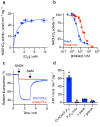Paracoccus denitrificans: a genetically tractable model system for studying respiratory complex I
- PMID: 33980947
- PMCID: PMC8115037
- DOI: 10.1038/s41598-021-89575-9
Paracoccus denitrificans: a genetically tractable model system for studying respiratory complex I
Abstract
Mitochondrial complex I (NADH:ubiquinone oxidoreductase) is a crucial metabolic enzyme that couples the free energy released from NADH oxidation and ubiquinone reduction to the translocation of four protons across the inner mitochondrial membrane, creating the proton motive force for ATP synthesis. The mechanism by which the energy is captured, and the mechanism and pathways of proton pumping, remain elusive despite recent advances in structural knowledge. Progress has been limited by a lack of model systems able to combine functional and structural analyses with targeted mutagenic interrogation throughout the entire complex. Here, we develop and present the α-proteobacterium Paracoccus denitrificans as a suitable bacterial model system for mitochondrial complex I. First, we develop a robust purification protocol to isolate highly active complex I by introducing a His6-tag on the Nqo5 subunit. Then, we optimize the reconstitution of the enzyme into liposomes, demonstrating its proton pumping activity. Finally, we develop a strain of P. denitrificans that is amenable to complex I mutagenesis and create a catalytically inactive variant of the enzyme. Our model provides new opportunities to disentangle the mechanism of complex I by combining mutagenesis in every subunit with established interrogative biophysical measurements on both the soluble and membrane bound enzymes.
Conflict of interest statement
The authors declare no competing interests.
Figures





Similar articles
-
Respiratory Complex I in Bos taurus and Paracoccus denitrificans Pumps Four Protons across the Membrane for Every NADH Oxidized.J Biol Chem. 2017 Mar 24;292(12):4987-4995. doi: 10.1074/jbc.M116.771899. Epub 2017 Feb 7. J Biol Chem. 2017. PMID: 28174301 Free PMC article.
-
Structure of the turnover-ready state of an ancestral respiratory complex I.Nat Commun. 2024 Oct 29;15(1):9340. doi: 10.1038/s41467-024-53679-3. Nat Commun. 2024. PMID: 39472559 Free PMC article.
-
Protonmotive Q cycle pathway of electron transfer and energy transduction in the three-subunit ubiquinol-cytochrome c oxidoreductase complex of Paracoccus denitrificans.J Biol Chem. 1988 Aug 25;263(24):11962-70. J Biol Chem. 1988. PMID: 2841340
-
C1 metabolism in Paracoccus denitrificans: genetics of Paracoccus denitrificans.J Bioenerg Biomembr. 1991 Apr;23(2):187-210. doi: 10.1007/BF00762217. J Bioenerg Biomembr. 1991. PMID: 2050654 Review.
-
Metabolic regulation including anaerobic metabolism in Paracoccus denitrificans.J Bioenerg Biomembr. 1991 Apr;23(2):163-85. doi: 10.1007/BF00762216. J Bioenerg Biomembr. 1991. PMID: 2050653 Review.
Cited by
-
Structure of mycobacterial respiratory complex I.Proc Natl Acad Sci U S A. 2023 Mar 28;120(13):e2214949120. doi: 10.1073/pnas.2214949120. Epub 2023 Mar 23. Proc Natl Acad Sci U S A. 2023. PMID: 36952383 Free PMC article.
-
Dissected antiporter modules establish minimal proton-conduction elements of the respiratory complex I.Nat Commun. 2024 Oct 22;15(1):9098. doi: 10.1038/s41467-024-53194-5. Nat Commun. 2024. PMID: 39438463 Free PMC article.
-
Hidden Markov Model-Based Prokaryotic Genome Space Mining Reveals the Widespread Pervasiveness of Complex I and Its Potential Evolutionary Scheme.Genome Biol Evol. 2025 Jul 30;17(8):evaf154. doi: 10.1093/gbe/evaf154. Genome Biol Evol. 2025. PMID: 40795046 Free PMC article.
-
Making the leap from structure to mechanism: are the open states of mammalian complex I identified by cryoEM resting states or catalytic intermediates?Curr Opin Struct Biol. 2022 Dec;77:102447. doi: 10.1016/j.sbi.2022.102447. Epub 2022 Sep 7. Curr Opin Struct Biol. 2022. PMID: 36087446 Free PMC article. Review.
-
The Mysterious Multitude: Structural Perspective on the Accessory Subunits of Respiratory Complex I.Front Mol Biosci. 2022 Jan 3;8:798353. doi: 10.3389/fmolb.2021.798353. eCollection 2021. Front Mol Biosci. 2022. PMID: 35047558 Free PMC article. Review.
References
Publication types
MeSH terms
Substances
Grants and funding
LinkOut - more resources
Full Text Sources
Other Literature Sources

